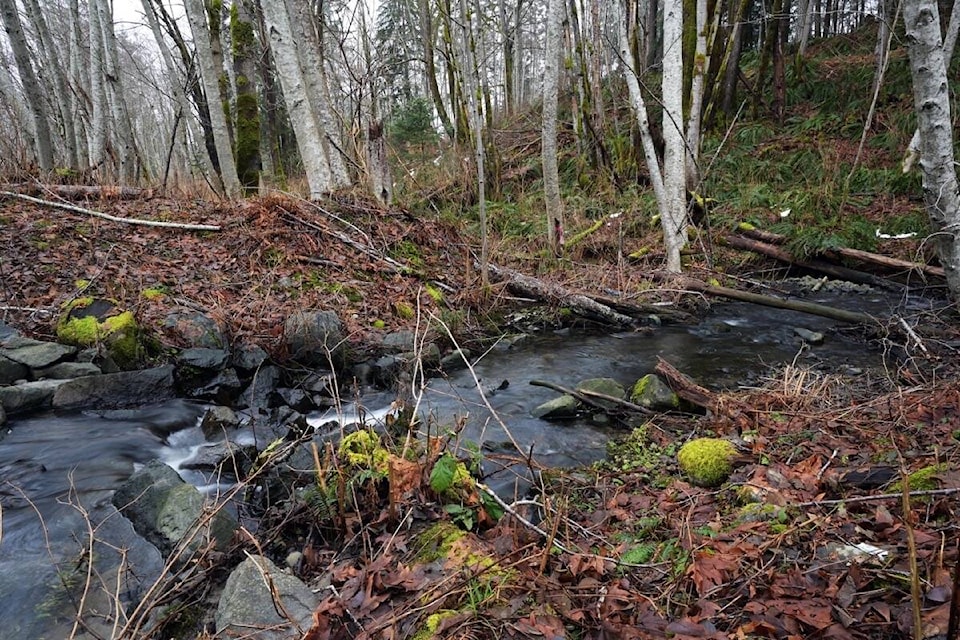During a public hearing for a proposed residential development south of Quinsam Road in Campbell River, several locals voiced concerns over the project’s potential impacts, while its applicant said it will help meet demand for new housing.
The hearing, held on the evening of Jan. 24, was a requirement of a land rezoning application for the 350- to 400-unit development. City council approved the first and second reading of the associated rezoning bylaw on Dec. 13, 2021.
RELATED: City council considering rezoning for ‘complex’ Quinsam Road development
During the hearing, applicant John Kelly said the project offers housing-starved Campbell River an array of housing types, including “more affordable” housing, while also respecting the natural environment of the site. The two parcels it spans feature mature forests, steep slopes, wetlands, and watercourses, including sections of both East Haig-Brown Kingfisher Creek and West Haig-Brown Kingfisher Creek, which meet before flowing into the Campbell River to the north.
Kelly said the first step taken on the project was contacting an environmental consultant, Mainstream Biological, to identify the most environmentally significant areas on the site. The resultant development plan places housing and roads on the least sensitive areas, while offering significant protection in perpetuity to the most sensitive areas, he said.
Under the plan, of the 47-hectare site, about 16 hectares will be housing development, plus roads and pathways — leaving about 61 per cent of the site as either parks or in a “natural state,” he said.
The development would match what many now want in a home, said Kelly.
“Market trends and our own research tell us a large segment of homebuyers are looking for smaller footprint homes (with) smaller yards, complemented with significant green space, easily accessible and in their general area,” he said. “I believe this project is one of the best examples that I’ve seen in 40 years of a balance between the economics, the environment, and the development community.”
But several speakers at the public meeting said they are concerned about the immediate and long-term impacts of the development, particularly on the local environment, with some also sharing property and traffic concerns.
Kenneth Enns, resident and co-owner River Sportsman, said approving the development would fly in the face of environmental restoration work completed in the area. This work includes a project that improved both East and West Haig-Brown Kingfisher Creek in 2015 and 2016, which Enns said cost around $750,000.
“What example are we setting as a community and municipality on a BC Heritage River, the homestead of Roderick and Ann Elmore Haig-Brown?” he said. “The fact that we are even having this meeting about the future of Haig-Brown’s land — when so much work has been done to expand the water, wetlands, and create a more diverse ecosystem — is bullshit.”
In a Jan. 24 letter to council, Campbell River Environmental Committee (CREC) president LeRoy McFarlane and vice president Leona Adams, said the committee too is opposed to the project due to the environmental significance of the site.
Others in the meeting also raised concerns about the development.
Catherine Slater, a Quadra Island resident trained in biology and environmental law, said the project will be ecologically detrimental, no matter the specifics of its plan.
“No amount of environmental setbacks or clustered development (and) parks, can undo the overall harm this development will do to this natural area,” she said. “This development will cause permanent deforestation, fragmentation, and loss of natural habitat. This area will never be the same healthy, natural area again.”
RELATED: Institute only new, safer and healthier ideas of Smart Growth development in Campbell River: letter
Another speaker (name unconfirmed), a We Wai Kai Nation member, said they were concerned local Indigenous perspectives were not considered in the plan.
“Not one mentioned the Treaty Society, or A-Tlegay Fisheries (Society), and how this impacts us,” she said. “I’m going to make a suggestion that you donate that land back to either the We Wai Kai Nation or the We Wai Kum Nation, who it belonged to originally, or allow us to purchase it back.”
Following the hearing, city council will consider third reading of the proposed bylaw at an upcoming meeting.
RELATED: B.C. seeks public input on new watershed protection strategy
sean.feagan@campbellrivermirror.com
Like us on Facebook and follow us on Twitter
